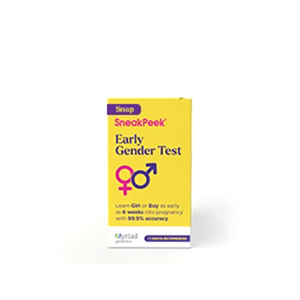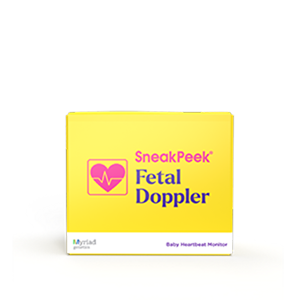Published on September 7th, 2021 and Updated on January 15th, 2024
Check out SneakPeek Gender Test to find out your baby’s gender as early as 6 weeks at over 99% accuracy1!
You’ve likely seen it more than once—a baby in a stroller, grocery store cart, or Mom’s lap, happily munching from a plastic bag of Cheerios. Affordable, easily transportable, and made of 100% natural oat, Cheerios have become a staple snack for babies, especially when Mom is on the go. As a new mom yourself, you may wonder:
When can babies have Cheerios?
Generally, your baby can start eating Cheerios around 7 to 9 months, when he’s able to pick up finger foods and feed them to himself. However, there are other developmental milestones you should look out for when deciding to introduce this snack into your little muncher’s diet.
Cheerios Shouldn’t be Your Baby’s First Food
Even if your baby has moved on to eating solid foods, it’s best to not serve them Cheerios right away. Cheerios don’t dissolve very quickly, so it’s important that your baby has a good handle on the eating process before introducing them to Cheerios. The first foods your baby should eat are purees and baby food made from soft fruit and vegetables before solid food. Cheerios are a great option later down the road for baby nutrition.
How to Tell When Your Baby is Ready to Eat Cheerios
Around 6 months old, you may notice your baby starting to reach for the foods that you’re eating. While this is due in part to curiosity, it’s also one of the signs that your baby is ready to expand her daily menu and start exploring the world of solid foods. But before you give in to your little foodie’s desires, confirm that she’s also able to:
- Make a chewing motion – Even if your little chomper doesn’t have, well, chompers yet, you should still see her making a chewing motion with her mouth when mashing food with her gums.
- Sit upright without support – Before serving any solid finger foods, be sure your baby can stay upright on her own with control over her neck. Otherwise, she may slump forward or sideways while eating, which can increase her risk of choking.
- Extrusion reflex has stopped – Also known as the tongue-thrust reflex, this reflex is instinctive and protects baby from choking or aspirating their food. This happens when you feed your baby and they push the food out with their tongue. The extrusion reflex ending is a sign that your baby is ready for Cheerios.
- Use the pincer grasp to pick up small objects – The pincer grasp refers to the ability to use two fingers to grab and hold an item. This allows your baby to bring finger foods to her mouth on her own. Because Cheerios have a hole in the middle, they’re typically easy for infants to grasp. While the correct pincer grasp uses the tips of the thumb and index finger to pick up an item, you may first notice your baby using other types of grasps as she develops this particular skill. These may include:
- Raking grasp – With this method, your baby will use her fingers to slide the Cheerio (or other solid item) toward her palm. She’ll then cover the item with her hand, squeeze it into her fist, and bring her fist to her mouth. Often, parents see this type of grasp develop around 6 months.
- Crude pincer grasp – Around 7 months, you may see your baby getting closer to perfecting her pincer grasp by using the pads of her thumb and index finger to grab finger foods or objects.
If your baby isn’t displaying any pincer skills yet, don’t worry. Every baby progresses at her own pace. Until she reaches this developmental milestone, you can still try introducing solid foods by spoon-feeding her infant cereal.
Infant Cereals
Around the 6-month mark, your pediatrician will likely suggest incorporating solid foods into your baby’s diet. One of the most common starter foods is infant cereal mixed with breast milk or formula.
It’s important to note that dairy and non-dairy milks shouldn’t be introduced into your baby’s diet until he’s over 1 year old, as these milks don’t contain the same quantities of iron and vitamin C that breast milk and formula do. Plus, research has found that early exposure to cow’s milk can increase a baby’s risk of developing type 1 diabetes, iron deficiency anemia, and milk protein allergies.
When mixed with breast milk or formula, baby cereals offer an easy-to-eat, healthy starter food option, particularly because they’re fortified with iron—a mineral that is an important part of infant neurological development.
Some of the highest-rated baby cereals to try are:
- Happy Baby Oatmeal – Along with oatmeal and iron, this baby cereal is high in vitamin C, which helps increase the absorption of iron into the body.
- WutsupBaby Organic Quinoa Infant & Baby Cereal – The main ingredient in this organic cereal is quinoa—a superfood high in dietary fiber, which may play a crucial role in developing a healthy gut and preventing constipation.
- Gerber Cereal Organic Variety Pack – A well-known name in the baby food industry, Gerber’s non-GMO, organic cereal variety pack allows you to introduce your baby to oatmeal, rice, whole wheat, and multigrain cereals while delivering essential nutrients such as iron, zinc, calcium, vitamin C, and vitamin E.
Are Cheerios healthy?
In moderation, original Cheerios or “regular Cheerios” are considered a healthy baby snack option for children. They contain significantly less sugar than many other cereals and offer essential vitamins and minerals. In fact, a ¾ cup serving of Cheerios only contains 1 gram of sugar. Compare this to other cereals, and you’ll see why Cheerios reign supreme.
For instance, Life cereal contains 6 grams of sugar per ¾ cup serving. Even Cheerios’ sweeter counterpart, Honey Nut Cheerios, contains a whooping 9 grams of sugar per ¾ cup serving. Start serving your baby too much sugar too early, and she’s likely to prefer sweeter foods throughout the rest of her life. Not only is this unhealthy, but it also means you’ll be fighting tougher battles later on when trying to get your growing child to please eat this broccoli.
But it’s not just what Cheerios lack that make this popular breakfast cereal a pediatrician-approved snack. Along with folate, vitamin B6, and magnesium, one serving of Cheerios also contains:
- 2 grams of fiber
- 2 grams of protein
- 6.3 mg of iron
Besides these benefits, the basic ingredients of cheerios are: Whole Grain Oats, Corn Starch, Sugar, Salt, Tripotassium Phosphate. Vitamin E (mixed tocopherols) Added to Preserve Freshness.
What about preservatives?
After perusing the nutrition label on your box of Cheerios, you’ll notice the ingredients. And while you’re likely to recognize the first few—whole grain oats, corn starch, sugar, and salt—you may not be as familiar with one of the last ingredients listed: tripotassium phosphate.
Tripotassium phosphate is an FDA-regulated preservative added to many processed foods, including cereals, cheese, and baked goods, to improve their texture and prevent them from spoiling. Consuming significant amounts of tripotassium phosphate can increase levels of phosphates in the body, which may cause heart disease and kidney issues. However, when consumed in moderation, tripotassium phosphate is considered safe, so serving your baby Cheerios every now and then won’t lead to any serious health issues.
Are Cheerios a choking hazard?
Because Cheerios are easily dissolvable with a bit of liquid, they’re extremely safe to feed to infants because they don’t pose the same choking hazard other small foods do. Once a Cheerio is in your baby’s mouth, saliva quickly turns that crunchy little circle into a mushy, mashable treat.
In fact, in one study that assessed the choking potential of common baby finger foods, Cheerios received high marks for their dissolvability. This, along with their affordability, explains why Dr. Ruth Milanaik, director of the neonatal follow-up program at the Cohen Children’s Medical Center, named Cheerios as the baby finger food that provides “the best bang for your buck.”
Regardless of dissolvability, it’s always smart to stay within arm’s reach of your baby when serving finger foods to ensure his safety.
Can babies be allergic to Cheerios?
While any type of food can trigger an allergic reaction, the chances that your baby is allergic to Cheerios is extremely low. This is because the primary ingredient in Cheerios is oats, which is not a food that commonly causes food allergy reactions. In fact, 90% of food allergies in children are caused by the following foods:
- Milk
- Eggs
- Peanuts
- Tree nuts
- Soy
- Wheat
Still, it’s always best to monitor your child when introducing a new food in case an allergic reaction does occur. Reactions can range from mild to severe, and may present in any of the following ways minutes or hours after eating the offending food:
- Hives or skin rash
- Itching
- Swelling of the face, tongue, or lips
- Wheezing
- Vomiting
- Diarrhea
If you notice mild symptoms of an allergic reaction, contact your doctor right away. If your baby is experiencing severe symptoms, immediately call 911.
What about Honey Nut Cheerios?
Honey Nut Cheerios may be popular among adults, but you shouldn’t share them with your adorable breakfast companion just yet. In addition to being high in sugar, Honey Nut Cheerio also contains honey—a food that’s dangerous to serve children younger than 1 year old. This is because honey can become contaminated with a bacteria called clostridium bacteria. In fact in a 2018 study of 240 multi-floral honey samples, researchers found that 2.1% of samples contained clostridium bacteria.
Why is clostridium bacteria bad for babies, but not for adults?
Adult digestive systems are able to pass these bacteria spores through the body quickly, while less-developed digestive systems, like those found in your baby, cannot. This allows the botulism spores or the clostridium botulinum spores to colonize the intestines and produce botulinum neurotoxin—a toxin that causes paralysis of peripheral nerve terminals. The result is a medical condition called, infant botulism, which causes:
- Muscle weakness
- Constipation
- Diminished sucking reflexes
- Weakened cries
- Difficulty breathing
While early diagnosis and treatment can resolve infant botulism, it’s an illness that’s potentially fatal. To avoid the risk altogether, doctors recommend keeping honey and processed food that contains honey (such as Honey Nut Cheerio) off your little one’s menu until she’s 1 year old.
Other Fun Ways to Serve Your Baby Cheerios
Once your baby has mastered his pincer grasp and is enjoying Cheerios on the reg, consider adding other nutritious treats to his tasty snack. Just remember: avoid adding any ingredients your baby hasn’t tried yet to ensure he’s not allergic to them.
Strawberry or Banana Cheerios – Add mashed strawberries or bananas to your baby’s bowl of Cheerios for a yummy blast of fresh fruit flavor. However, make sure you get the answer to the question “when can babies have strawberries?” first since these can cause allergic reactions.
Cheerio Snack Plate – Make your baby his own infant cheese board by serving his Cheerios alongside shredded cheese and thinly sliced fruit.
Before introducing your baby to any new treat or beverage with Cheerios, be sure to always check first. This includes asking questions like “when can babies have chocolate?”, or “when can babies have salt?”.
Introducing Cheerios to your baby’s diet can be an exciting milestone, but it’s crucial to ensure your little one is developmentally ready, demonstrating skills like sitting upright without support and displaying a pincer grasp. While Cheerios offer a healthy snacking option given their low sugar content and essential nutrients, they should be introduced as part of a balanced diet, with careful monitoring for any potential allergic reactions.
Sources:
Solid Starts. Can Babies Eat Cheerios? ??https://solidstarts.com/can-babies-eat-cheerios/
Very Well Family. The 7 Best Baby Cereals of 2021, According to a Dietitian. ??https://www.verywellfamily.com/best-baby-cereals-5112693
Today. Some ‘first finger foods’ for baby are a choking hazard, study finds. ??https://www.today.com/health/some-first-finger-foods-baby-are-choking-hazard-study-finds-t89916
Kids Health. Infant Botulism. https://kidshealth.org/en/parents/botulism.html
CDC. Infant Botulism: Information for Clinicians. https://www.cdc.gov/botulism/infant-botulism.html#:~:text=Infant%20botulism%20is%20an%20intestinal,intestine%2C%20and%20 produce%20botulinum%20neurotoxin.
What to Expect. When Can Babies Eat Cereal? ??https://www.whattoexpect.com/first-year/baby-feeding/when-can-babies-eat-cereal
Healthline. When Can Babies Have Milk? Why It’s Important to Wait. https://www.healthline.com/health/baby/when-can-babies-drink-milk
NCBI. Whole cow’s milk in infancy. https://www.ncbi.nlm.nih.gov/pmc/articles/PMC2791650/
NCBI. Dietary fibre in infancy and childhood. https://pubmed.ncbi.nlm.nih.gov/12740052/
Healthline. Read the Label: Your Child’s Baby Food May Have Too Much Sugar. ????https://www.healthline.com/health-news/how-you-can-tell-if-your-childs-baby-food-has-too-much-sugar#Developing-a-sweet-tooth-early
NCBI. Phosphate Additives in Food—a Health Risk. https://www.ncbi.nlm.nih.gov/pmc/articles/PMC3278747/
Healthy Children. Common Food Allergies. https://www.healthychildren.org/English/healthy-living/nutrition/Pages/Common-Food-Allergies.aspx
NCBI. Clostridium botulinum spores in Polish honey samples. https://www.ncbi.nlm.nih.gov/pmc/articles/PMC6167343/

Shop Our Products
SneakPeek aims to provide the most accurate and up-to-date information to help our readers make informed decisions regarding their health before, during, and after pregnancy. This article was written based upon trusted scientific research studies and/or articles. Credible information sources for this article are cited and hyperlinked.





